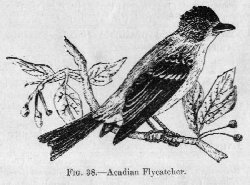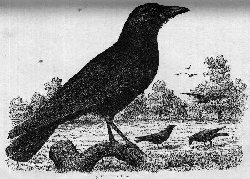FAMILY TYRANNIDÆ.裕YRANT FLYCATCHERS.
The various species of flycatchers, as the name implies, feed upon insects which they capture for the most part while on the wing. Flies and allied insects are quite prominent on the bill-of-fare; but these by no means are the only kinds of insects destroyed by them. Many a luckless locust, butterfly, moth or even beetle is snapped up and devoured by the different species of the family.
The "Bee-bird", or Kingbird as it is more frequently called, some times even catches bees. These latter, however, consist largely of drones, and hence comparatively little harm is done. If worker bees should be persistently destroyed by some individual bird that develops an abnormal appetite, be should he killed.
443. Milvulus forficatus (Gmel).祐CISSOR-TAILED FLYCATCHER.
Once near Lincoln, fall of 1872 (L. Bruner); "Accidental * * * Manitoba, and even at York Factory Hudson痴 Bay Territory" (Goss).
444. Tyrannus tyrannus (Linn.).揖INGBIRD; BEE-BIRD.
All parts of state, breeds (L. Bruner); "Abundant as far west as the middle of Nebraska" (Aughey); "Summer resident, abundant, arrive in April and May, leave in September" (Taylor); "Chiefly east of the Rocky mountains" (Goss); Beatrice, De Witt溶esting (A. S. Pearse); Omaha傭reeds (L. Skow); Peru, common傭reeds (G. A. Coleman); Cherry county傭reeds (J. M. Bates); Gage county傭reeds (F. A. Colby); Omaha, common summer resident, arrives April 20 to May 12, breeds May 16 to 30, departs about September 15" (I. S. Trostler).
447. Tyrannus verticallis Say.--ARKANSAS FLYCATCHER.
West Point, Sidney, Ft. Robinson. Lincoln, etc., breeds (L. Bruner); "This bird abounds along the wooded streams in southwestern Nebraska" (Aughey): "Summer resident, common, arrives in May" (Taylor); "Western United States, east to Missouri and western Minnesota" (Goss); Omaha (L Skow); Cherry county傭reeds (J. M. Bates); "a scarce summer visitor, one seen September, 1895" (I. S. Trostler).
452. Myiarchus crinitus(Linn.).宥REAT-CRESTED FLYCATCHER.
West Point (L. Bruner); southeastern portion of state (Aughey); "Summer resident, common" (Taylor); "East [west?] to the edge of the Great Plains" (Goss); Omaha傭reeding (L Skow); Peru, common傭reeds (G. A. Coleman); Lincoln (D. A. Haggard); "a not rare summer resident傭reeds in June" (I. S. Trostler).
456. Sayornis phœbe Lath.).猶HŒBE; PEWEE.
Omaha, Lincoln, West Point (L. Bruner); breeds, along the Missouri (Aughey); "Summer resident, common" (Taylor); "West to eastern Colorado and western Texas" (Goss); Beatrice, De Witt傭reeding (A. S. Pearse); Omaha傭reeds (L Skow); Peru, common, breeds (G. A. Coleman); Cherry county傭reeds (J. M. Bates); Gage county傭reeds (F. A. Colby); "a common summer resident, earliest seen 15th傭reed in late April, depart in September" (I. S. Trostler).
467. Sayornis saya (Bonap.).祐AY担 PHŒBE.
Lincoln (L. Bruner) "Have only observed it in central and western Nebraska" (Aughey); "Abundant in western Nebraska, where it breeds" (Taylor); "East to Dakota, south through middle Kansas" (Goss); Omaha傭reeds (L. Skow); Summer resident, common," North Platte (M. K. Barnum).
459. Contopus borealis (Swains.).涌LIVE-SIDED FLYCATCHER.
Lincoln (L. Bruner); "only occasionally met it in Nebraska" (Aughey); "Summer resident, rare" (Taylor); "The whole of northern North America" (Goss);
461. Contopus virens (Linn.).邑OOD PEWEE.
Lincoln, Weeping Water, Nebraska City (L Bruner); eastern Nebraska (Aughey); "Summer resident, common" (Taylor) "West to edge of Great Plains" Omaha傭reeding (L. Skow); Peru, common傭reeds (G. A. Coleman); Omaha, "a not common summer resident, breeds" (I. S. Trostler).
462. Contopus richardsonii (Swains.).邑ESTERN WOOD PEWEE.
Sioux county, Dismal river (L Bruner); "Frequently seen wherever there is woodland or timber-skirted streams in western Nebraska" (Aughey); "Given by Bayard and Aughey as a summer resident in the western part of the state" (Taylor); "East to western Nebraska and Texas" (Goss); Omaha傭reeds (L. Skow).
463. Empidonax flaviventris Baird.雄ELLOW-BELLIED FLYCATCHER.
Lincoln, West Point (L. Bruner); sparingly in eastern Nebraska (Aughey).

465. Empidonax virescens (Vieill.). GREEN-CRESTED FLYCATCHER; ACADIAN FLYCATCHER.
West Point (L. Bruner); "West into Nebraska and middle Texas" (Goss); Omaha傭reeding (L. Skow); "a common summer resident, breeds in June and departs in September" (I. S. Trostler.)
466a. Empidonax traillii (Aud.).裕RAILL'S FLYCATCHER.
Omaha, Lincoln (L. Bruner); "most abundant of the two [forms]" (Aughey); "Migratory, rare, has been seen in the western part of the state in August" (Taylor); "Eastern North America, to the plains" (Goss); Omaha傭reeds (L. Skow); Peru, rare洋ay breed (G. A. Coleman); Omaha, "a common summer resident" (I. S. Trostler).
467 Empidonax minimus Baird.有EAST FLYCATCHER.
West Point, Omaha (L Bruner); "Rather common in Nebraska, and occasionally breeds in northeastern portion of the state" (Aughey); "Migratory, common; summer resident, occasional" (Taylor); "West to the Yellowstone river and base of Rocky mountains in Colorado" (Goss); Omaha傭reeds (L. Skow); "a rare summer visitor, one taken Aug. 2, 1892" (I. S. Trostler).
474. Otocoris alpestris (Linn.).幽ORNED LARK; SHORE LARK.
West Point, Lincoln, Omaha, etc. (L. Bruner); "A winter resident in Kansas and Dakota, and probably Nebraska" (Taylor); Covington, Nebr. (D. H. Talbot).
474a. Otocoris alpestris leucolæma (Coues).猶ALLID HORNED LARK; WHITE-THROATED HORNED LARK.
West Point (L. Bruner); Lincoln (Aughey); Omaha傭reeds (L. Skow); Cherry county傭reeds (J. M. Bates); Lincoln (F. J. Brezee, D. A. Haggard); Omaha, abundant resident傭reeds (I. S. Trostler).
474b. Otocoris alpestris praticola Hensh.--PRAIRIE HORNED LARK.
West Point, Omaha, Lincoln傭reeds (L Bruner); "Some seasons quite abundant in eastern Nebraska" (Anghey); "Common, probably a resident" (Taylor); "West to central Dakota and Kansas" (Goss); Beatrice, De Witt (A. S. Pearse); Omaha傭reeds (L. Skow); Peru傭reeds, common (G. A. Coleman): Gage county傭reeds (F. A. Colby); Omaha, "an abundant resident, found breeding March 23 to July 20" (I. S. Trostler).
474c. Otocoris alpestris arenicola Hensh.--DESERT HORNED LARK.
Hat creek basin, Sidney (L. Bruner); "Resident, common" (Taylor); "Resident in the western to middle portion of the state "揖ansas (Goss); Omaha� breeds (L Skow); Cherry county傭reeds (J. M. Bates); Sioux county, Feb. 18 to 26, very numerous (L. Bruner, W. D. Hunter, L. Skow).
FAMILY CORVIDÆ.--CROWS, JAYS, MAGPIES, ETC.

One should be unprejudiced in order to write a fair biography of even a bird, or group of birds. To say that I am without such prejudice with reference to some of the members of the family of birds now under consideration, would be a falsehood. Still, I shall endeavor to give as unbiased testimony as possible with reference to their food-habits at least, and let the reader judge for himself as to what would be the proper treatment for these birds.
Taking the family as a whole, it is made up of birds like the crows, ravens, magpies, jays, nut-crackers, camp-robbers, etc., many of which have unenviable reputations at least if they are not really as bad as we are sometimes requested to believe they are.
The crows, ravens, magpies, and immediate relatives are what might be termed "omnivorous" in food-habit---eating everything that comes their way. The crows, however, have been shown to feed largely upon insects, which in a great measure, at least, offsets the harm done in other directions. They also feed upon various substances, the removal of which is for the general good.
The Raven is too rare a bird in this state to be taken into consideration in respect to food-habit, and the Magpie certainly can be put out of the question of doing any possible harm for the same reason. This leaves then to be considered, the jays, of which we seem to have six or seven distinct kinds: but only two of these are at all common. The Blue Jay is found over the entire state, and is familiar to everybody. The second species is found only in the western and northwestern portions among the pine forests, and is known as the Piñon Jay or Camp Robber葉he latter name not very flattering to the bird I must confess. For a more explicit account of each the reader is referred to the different species recorded below.
475. Pica pica hudsonica (Sab.) .輸MERICAN MAGPIE.
West Point, Norfolk, Harrison傭reeds latter locality (L. Bruner); "Occasional in northern and more common in western Nebraska" (Aughey); "Fall and winter visitant, somewhat rare" (Taylor); summer resident (L. E. Hicks); "East to the edge of the plains" (Goss); Cherry county-breeds (J. M. Bates); Cherry county, breeding (I. S. Trostler)
Continue
Back to Legacy.
© 2001, Lynn Waterman